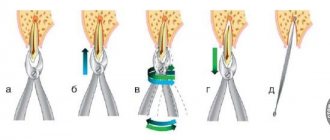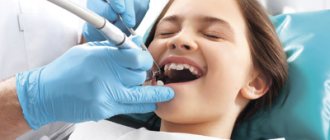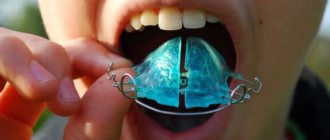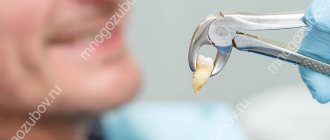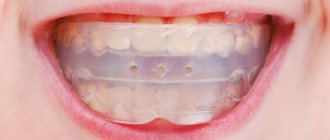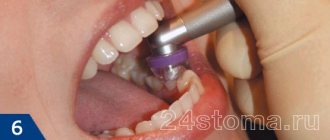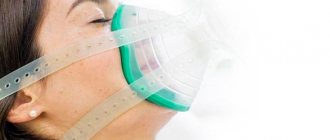Chief editor of the site:
Snitkovsky Arkady Alexandrovich
Chief physician of the professorial dentistry “22 Century”, dentist, orthopedic dentist
Author of the article:
Scientific team of dentistry “22 Century”
Dentists, candidates and doctors of medical sciences, professors
In modern Dentistry “22 Century” dental treatment is painless for the patient
Throughout their lives, most people repeatedly have to consult doctors - dentists of various specialties for the treatment of various dental diseases or, less often, for their prevention. In addition, pathological processes can occur several times, and most are accompanied by pain, the severity of which is determined by the rich mixed innervation of the head and neck.
It is pain that is the “watchdog” of the body, which is the signal of trouble that forces the patient to visit the dental clinic in order to get rid of it or at least reduce it as soon as possible. What can a strong or prolonged attack lead to?
- Disturbance of the balance of the internal environment of the body and the mechanisms of its regulation;
- Adverse effects on the function of organs and systems of the body;
- Increased risk of exacerbation of concomitant diseases;
- Decreased quality of life (impossibility of usual social activities).
From all that has been said, the enormous negative significance of this pathological condition clearly follows.
However, does this mean that complex treatment will also be uncomfortable or even painful for the patient? Of course not!
Dispelling fears
When faced with the need to visit the dentist, we all hope that we will be treated without pain, but intuitively, we tune in to it in advance and cannot do anything about this feeling. No matter how hard we try, we are afraid to treat our teeth. However, it is possible to overcome your fears before visiting the dentist, and it is very easy to do. Psychological fear will go away only after actual treatment without pain. In a good clinic, the myth about pain-free dental treatment will be turned into reality.
Today, dentistry has an extensive arsenal of modern methods of treating teeth and the oral cavity, the latest diagnostic methods, as well as the most innovative drugs and technologies that help treat teeth quickly, effectively, but absolutely without pain. With the help of this entire set of tools, you can eliminate both minor teeth flaws and solve more serious dental problems without pain.
Local anesthesia
Local anesthesia in dentistry
In the arsenal of our dentistry there are many methods of anesthesia (“freezing”), the leading of which is the so-called. local injection. It involves blocking the conduction of nerve impulses from the source of irritation to the brain and spinal cord while maintaining consciousness and the possibility of verbal contact. The leading role in outpatient practice is ensured by:
- Availability (the most used drug in dentistry);
- Ease of implementation;
- Quality (automated production in sterile factory conditions);
- High efficiency (sufficient depth and duration of action);
- The speed of onset of the effect (“at the tip of the needle”);
- Comparative safety (rare occurrence of complications or their mild severity);
- Low cost.
The constant expansion of the range of anesthetics and instruments used, new application technologies and methods make it possible to carry it out at any dental appointment. Previously, for anesthesia , the patient was redirected to a surgical room or department, which made treatment difficult.
Indications for local anesthesia
Indications for local anesthesia in dentistry
- Prevention of discomfort during:
- professional oral hygiene – “cleaning” (especially for the removal of subgingival tartar from the inner surface of the front teeth on the lower jaw);
- teeth whitening;
- diagnostic manipulations (measuring the depth of periodontal pockets, determining the level of alveolar bone tissue, etc.).
- Treatment of caries (cavity preparation followed by placement of fillings from various materials).
- Treatment of complications of caries - pulpitis and periodontitis, which involves creating access to the tooth cavity, removing its contents, treating the root canal system and filling them. Subsequently, the crown is restored using therapeutic (pin, filling) or orthopedic methods - stump inlays and crowns.
- Extraction of teeth of varying degrees of complexity.
- Operations on soft tissues of the oral cavity:
- plastic surgery of the frenulum of the upper and lower lip and tongue;
- plastic surgery of the oral vestibule (vestibuloplasty);
- elimination of gum recession (loss at the neck of the tooth, “exposing” the root);
- flap periodontal operations;
- increase in the volume of attached gums.
- Dental implantation is the installation of artificial roots made of titanium alloy into the jaw bone tissue for the purpose of subsequent prosthetics.
- Operations on the bone tissues of the jaws:
- open and closed sinus - lifting (an operation to raise the bottom of the maxillary sinus in order to create sufficient height for the installation of dental implants);
- ridge splitting – creating sufficient width of bone tissue before implantation;
- directed bone regeneration – local creation of a bone base in case of its deficiency.
- Dental treatment in children (also serves as an effective measure to prevent fear of treatment and the development of dental phobia, which allows timely seeking dental care).
Properly selected and high-quality anesthesia
However, any painless treatment at the dentist is only possible with correctly selected and high-quality anesthesia. Of course, we will not talk about individual cases of insensitivity to anesthesia, but in other cases it is possible to guarantee 100% painless treatment. Modern painkillers are so high-quality and fast-acting that you simply go to the dentist at any time convenient for you, they give you anesthesia, half an hour and you are free again. Moreover, after the visit you will not have any unpleasant sensations, you will be able to quickly get back into the usual rhythm of life.
In many ways, the quality of the anesthesia performed will depend not only on the drug used, but also on the professionalism of the doctor conducting the treatment. Thus, the final result of the entire treatment, as well as the impression of a visit to the dentist, will also depend on the skill, professionalism, if not the virtuosity of the doctor himself.
Can an injection be painless?
Patients often have a fear of anesthesia injection. To reduce discomfort, ILATAN dental doctors:
- Use special syringes with very thin needles;
- Dry the mucosal area before injection to facilitate the passage of the needle;
- Lubricate the injection sites with anesthetic gel;
- The medicine is administered gradually.
Regular visits to the dentist
Dental treatment without pain and relieving the psychological problem of fear of visiting a dentist will allow you to see a doctor more often, rather than postponing the visit until later, when you can no longer endure it. The health of your teeth will always be under control. It has been noticed that patients treated in good dentistry become more disciplined and are happy to return to the clinic for a preventive examination. This once again confirms the rule that dental care and treatment should be carried out only in dentistry with a good reputation.
What is dental phobia and who is most afraid of it?
Over the past decade, the range of medicines and methods of practical dentistry has expanded significantly. Now in its arsenal there are effective technologies, high-quality devices, new materials that can not only guarantee the quality of treatment, but also ensure its comfort.
Despite this, one of the most common reasons for refusing to visit the dentist remains dental phobia - the patient’s fear of dental intervention. From medical practice we know that 90% of adults have a fear of pain, they anticipate it, even when they don’t see the instruments yet, just think about treatment!
There are interesting statistics on this: managers at various levels are most afraid of dentists - about 67% and housewives - 72%. And the bravest, in this regard, are military personnel - 72% of them are not afraid of us =).
It's true. Our doctor, Diana Levchuk, at the very beginning of her career, worked in a dental clinic and received conscripts from the nearest military unit. Maybe it was her gentle approach, of course, but they were very happy when they got into her office =). Perhaps this is due to the hardships of service, but a fact is a fact.
Modern dentistry should be pain-free
Today, pain-free dental treatment is the only sure guarantee of dental work with a good reputation. Modern painkillers have no side effects, and their use does not cause any discomfort. Good anesthesia is important not only for the patient, but also for the doctor. Doing your job calmly and professionally with a relaxed patient is always more acceptable.
Modern dentistry should be pain-free, with the most modern technological and medicinal equipment, with a professional team of highly qualified doctors, with friendly staff, with the feeling that you have come to your family doctor. We wish you to find your own dentistry, when you come to it you can say: “Treating teeth without pain is a reality!”
When is local anesthesia not used?
Contraindications to local anesthesia in dentistry
- Hypersensitivity to one of the components included in the anesthetic – a history of allergic reactions.
- Ineffectiveness of local anesthesia (for example, at the site of inflammation).
- Long duration and/or complexity of the intervention, the need to anesthetize a large number of anatomical structures or area of the surgical field.
The amount of drug used in this case will exceed the permissible amount and will have toxic and other side effects. Examples include:- operations for tumors;
interventions on the salivary glands;
- manipulations for traumatic injuries of the facial skeleton;
- orthognathic surgery – correction of bite by changing the position and size of jaw segments;
- craniofacial surgery.
- Insurmountable fear of treatment. In these cases, anesthesia is used - a type of general anesthesia, in which the patient is not conscious, or combined anesthesia with premedication - the use of drugs that induce a sleep-like state.
- Mental illness and behavioral disorders.
- Limited mouth opening. The following important points should be taken into account:
- the need to involve an anesthesiological team in the operation;
- potential risks during, before and after surgery;
- significantly higher price (sometimes exceeding the cost of treatment or comparable to it);
- representation mainly in Moscow and other large cities;
- the need for observation after recovery from anesthesia and surgery.
- A preliminary consultation and examination by an anesthesiologist is mandatory, who will determine the specific scheme for administering and maintaining anesthesia or another type of general anesthesia, medications and their dosage, etc. Taking into account ideas about the development of pain syndromes encountered during treatment, other groups of drugs are used:
- non-steroidal anti-inflammatory drugs;
- hormonal anti-inflammatory;
- antispasmodics;
- non-narcotic analgesics;
- narcotic analgesics;
- antidepressants.
How to treat caries: the main stages of the treatment process to be completed
Treatment of caries always begins with diagnosis, which establishes the stage of development of the disease. Diagnostic measures for caries may include a visual examination, the use of special caries indicator drugs, a laser, and radiography (a targeted picture is taken).
Based on the data obtained during diagnosis, the optimal caries treatment method for a specific clinical case is selected. Most often, a classic treatment regimen is used, which involves drilling the tooth with the removal of destroyed tissue, treating it with antiseptics and drugs that destroy the infection, and restoring the natural crown of the tooth with a light-curing filling.
Take a short test and calculate the cost of treatment!
Take a short test
Painless implantation techniques used in practice
There are two ways to install implants:
- One-stage – immediately after tooth extraction. During such an operation, an orthopedic structure (temporary crown) is installed immediately after the implant is implanted.
- Two-stage. At the first stage, a dental implant is installed, after which the gums are sutured. The second stage is to install the crown and abutment. It is implemented after 3-6 months from the moment the implant was installed (during this period of time the artificial root must fuse with the bone).
Tooth root caries: is it possible to treat and save the tooth?
Tooth root caries most often has to be treated in an advanced stage, since the gums prevent you from seeing the carious damage in this area. Therefore, patients come to the doctor only when the tooth begins to hurt.
Is it possible to treat and save a tooth with tooth root caries? The answer to this question will depend on how much the disease has damaged the tooth root. If the damage is significant, treatment will be carried out either by surgical methods, or the dentist will recommend that you remove the tooth and later restore it with prosthetics or implantation.
How does intravenous sedation differ from inhalational sedation?
- intravenous sedation – deeper, in which individually selected sedatives are administered intravenously, and the patient is immersed in a state of sleep (or half-asleep). Read about this type of pain relief in a separate article.
- inhalation sedation - the patient inhales a certain drug, but remains conscious, that is, reflexes are dulled, complete relaxation occurs and anxiety is relieved.
Intravenous sedation is used as an independent means of pain relief. But inhalation xenon often precedes other types of anesthesia. Since it does not have an analgesic effect, but is aimed at reducing the level of anxiety, local anesthesia (infiltration or conduction anesthesia) is additionally used, and less often, intravenous sedation. In the second case, xenon therapy is required for general stress relief before the upcoming treatment.
Anesthetics used for painless dental treatment
A good local anesthetic must satisfy a number of requirements:
- act quickly;
- have little toxicity;
- not absorbed into the systemic circulation;
- do not irritate the gums.
The selection of pain medication always occurs on an individual basis. The doctor takes into account the client’s age, his state of health, the treatment area, the threshold of pain sensitivity, and the characteristics of the existing disease.
More often than others, doctors use drugs containing articaine or mepivacaine.
Medicines based on articaine
Articaine is a local anesthetic belonging to the group of amides. It is characterized by a pronounced local anesthetic effect. Easily passes through the cell membrane into the nerve fiber. Blocks the conduction of nerve impulses along fibers.
Products containing this compound are used for uncomplicated removal of one or more molars, treatment of carious cavities, and grinding of crowns before prosthetics. It produces the medicine under the following trade names:
- "Ultracaine";
- "Ubistezin";
- "Septanest".
Painkillers containing mepivacaine
Mepivacaine is also an amide group anesthetic. It quickly passes through the lipid layer of the nerve cell membrane, is transformed into a cationic form and reacts with membrane sodium channel receptors. The latter are located at the endings of the nerves. Due to this, the conduction of impulses along nerve fibers temporarily becomes impossible.
Mepivacaine causes all types of local anesthesia:
- infiltration;
- terminal;
- conductor.
It acts very quickly and powerfully. Used for complex removal of radical units, during maxillofacial operations, tracheal intubation, esophagoscopy and bronchoscopy. Mepivacaine is used in the production of a medicine called Scandonest.
Don't put off dental treatment because you are afraid of dental pain. Today, doctors can carry out all manipulations with minimal discomfort for the patient, so there is no need to fear severe pain.
What are caries?
Caries can affect different parts of the tooth and according to the area of localization of carious damage, it is classified by type. Let's get acquainted with different types of caries and find out their characteristic features.
Cervical caries
It affects the neck of the tooth and develops quite quickly, because the natural enamel coating in this area is thin and often demineralized.
Cervical caries easily spreads to neighboring teeth and its main danger is that, if left untreated, pulpitis may occur, because the neck of the tooth is located quite close to the nerve of the tooth. By the way, for the same reason, a tooth with cervical caries can be quite painful. The treatment method for cervical caries is selected based on the stage of development of the disease. With medium and deep cervical caries, you cannot do without drilling the tooth, but if you see a white spot on the neck of the tooth and immediately contact the dentist, the tooth will be cured by remineralization or the infiltration method - icon technology.
YOU NEED TO REMEMBER! One of the reasons provoking the development of cervical caries may be the wrong choice of brush for cleaning teeth. A brush with hard bristles can damage thin tooth enamel. Frequent use of toothpastes with abrasive particles can have the same negative effect on the integrity of tooth enamel. From here we draw a simple conclusion: the choice of tools and materials for dental hygiene should be deliberate! If you don’t know how to choose the right brush and paste to keep your teeth healthy, come to our dental clinic in Moscow - “Firadent” and get from our doctors the most detailed professional advice on proper dental and oral hygiene!
Cervical caries requires urgent treatment, because the tooth is destroyed quickly and if the inflammation spreads to the pulp or root system, it will not always be possible to cure the tooth with conservative therapy. Sometimes, with deep cervical caries, a tooth has to be removed, and its subsequent restoration with prosthetics or implantation involves significant financial costs.
As an example and to motivate timely treatment of cervical caries or in any other form, let’s compare the prices for conservative therapy and implantation. You can cure average cervical caries in Moscow for 4-5 thousand rubles, the price of implantation starts from 50,000 rubles. The difference is huge, isn't it? Therefore, if you want to treat your teeth inexpensively, don’t delay visiting the dentist!
Types of anesthesia
Methods and painkillers differ significantly in the mechanism of action and the method of administration into the body. The following types of anesthesia are used in the field of therapeutic dentistry:
- Application – involves applying a special gel or spray based on an antiseptic. It is used at the site of an anesthetic injection, removal of dental plaque and when removing baby teeth.
- Infiltration - introducing a dose of anesthetic into the gum tissue by injection. With this injection, the nerve endings are completely blocked. The teeth and adjacent tissues completely lose their sensitivity. Under such anesthesia, it is possible to treat almost any dental disease and even perform minor operations.
- Conduction - this type of anesthesia involves delivering the drug directly to the branch of the trigeminal dental nerve, which blocks the transmission of impulses along the entire length of the nerve. This method is used in areas of dense bone formations of the lower jaw, because it is impossible to administer a direct injection into this area due to the insufficient width of the open mouth. The technique of performing conduction anesthesia is quite complex, and in itself can be painful, but it provides the longest and most lasting effect in the treatment of the lower and upper jaw.
Phobia or simply fear of dentists
A common fear of a drill can always be distinguished from such a serious problem as dental phobia. If a person goes to talk to a doctor, then most likely he is simply afraid. In this case, the specialist’s task is to find an approach to the patient and choose the right words. When a person realizes that there is nothing to be afraid of, he relaxes and may even fall asleep during the appointment. This happens only because he found contact with the doctor and trusted him. A patient suffering from dental phobia is non-communicative, he can faint only at the sight of a syringe, during the treatment he begins to interfere with the doctor with his hands or feet, he develops shortness of breath, his blood pressure rises sharply... In such situations, it becomes obvious that the person is really not able to control your fear, and this is a serious psychological problem.
How to prepare for treatment under inhalational sedation
Before implantation or dental treatment using sedation, unlike general anesthesia, no special preparation is required. The only restriction concerns food - 2-3 hours before the procedure you need to avoid consuming any foods, otherwise you may experience vomiting.
Possible contraindications are necessarily excluded. These include individual intolerance to the drug, bronchial asthma or epilepsy, acute diseases of the cardiovascular system, neuropsychiatric disorders, high intracranial pressure and acute immune disorders. The next stage is the obligatory informing of the patient about how the procedure is carried out and what sensations will arise.
How will you feel during the procedure?
At the initial stage, numbness of the skin, heaviness in the legs and throughout the body, changes in the perception of sound signals, dizziness, and loss of coordination may occur, but clarity of consciousness is maintained. Then comes a feeling of complete relaxation of the body, absence of painful irritation, and easy immersion in sleep. This entire range of sensations manifests itself in the first 5 minutes of exposure to the drug.
Xenon has an intoxicating effect and literally immerses a person in a feeling of euphoria. Therefore, some people (especially children) who are not familiar with this feeling may experience fear or even panic. But you need to understand that the effect of xenon can be stopped at any time, or the concentration can be increased so that the patient almost completely falls asleep.
Cost of services
Laser dentistry clinics in Moscow offer different prices for their services. By looking at our price list, you can make sure that at PROFI-Dent the prices for laser dentistry in Moscow are among the most affordable.
| Price list for laser dentistry at the PROFI-Dent clinic | |
| Sterilization of 1 channel with laser | 200 rubles |
| Pulpoextraction | 300 rubles |
| Sterilization of periodontal pocket (1 procedure) | 500 rubles |
| Laser analgesia | 800 rubles |
| Treatment of hyperesthesia (1 tooth) | 500 rubles |
| Laser treatment of pericoronitis (excision of the “hood” with a laser) | 1,500 rubles |
| Treatment of diseases of the oral mucosa using laser (1 visit) | from 400 rubles |
What treatment can be done under xenon sedation?
- dental treatment: removal of caries, treatment of root canals for pulpitis or periodontitis, removal of cysts and granulomas,
- any surgical operations,
- any treatment or prosthetics in case of panic among doctors,
- periodontal treatment within the framework of Smile Recovery complexes,
- dental implantation, both single and multiple – in this case, a higher concentration of the active substance is used, which allows for a more prolonged effect of the anesthetic, and also, if necessary, to put the patient into a medicated sleep.
Is it possible to treat caries at home, on your own?
Self-medication of dental caries is a useless exercise and, moreover, carries a high risk of developing all kinds of complications. Neither traditional medicine recipes nor antibiotics from the pharmacy will help achieve the main thing - stopping the development of caries. Even if you take away the pain in your tooth with pills or lotions, caries will still continue to destroy it. In an effort to cure caries on your own and inexpensively, you can “earn” complications that will require tooth extraction!
Treatment of caries without removing damaged tissue and eliminating pathogenic microflora is impossible, and these procedures are carried out only in a clinical setting and require the use of professional drugs and instruments.
Why you should trust us
- full control of the patient’s condition at all stages of treatment - monitoring of vital health indicators is carried out,
- use of high-quality drugs for both general anesthesia and sedation,
- certified doctors with extensive experience in performing such procedures.
Expert opinion
Nikolay Vladimirovich Namdakov Maxillofacial surgeon, implantologist, orthopedist Work experience 17+
“Our clinics offer various options for pain management - from classic “freezing” to sedation and general anesthesia. This allows both doctors and patients not to feel discomfort during treatment. General anesthesia in the clinic is carried out under the supervision of a licensed team of anesthesiologists and resuscitators. Such anesthesia is more expensive, but we must make the procedure as safe as possible for our patients. Sedation involves a milder effect - we have all the necessary equipment to carry it out, and the clinic’s specialists have undergone special training and have valid certificates.”
Disadvantages of treatment under general anesthesia and sedation
With a professional approach and high-quality training, taking into account all possible restrictions and contraindications, treatment under general anesthesia or sedation will not cause any harm. Naturally, the risk of individual intolerance remains, however, precisely for these purposes, in our clinic, manipulations are carried out under the supervision of experienced anesthesiologists and resuscitators.
What to choose - anesthesia or sedation, first of all, you need to decide based on the indications. If conventional local anesthesia is not enough, then at the treatment planning stage, the attending physician will discuss which anesthesia option is right for you. Taking into account health as well as personal preferences. For example, some patients are categorically against a slightly “foggy” creation when using xenon, so after passing all the necessary tests they boldly decide to undergo general anesthesia in dentistry.
Contraindications
Despite its apparent safety, sedation is not indicated for all categories of patients. Below is a list of who may benefit from local anesthesia only:
- small children under 3 years old. Due to their age, they cannot describe their feelings and condition;
- patients with respiratory diseases. Breathing may be impaired;
- pregnant women. There is concern that exposure to the gas will negatively affect the fetus. This is especially true for the first and third trimesters;
- patients with epilepsy. The gas can trigger an attack;
- people who have recently suffered a traumatic brain injury. Increased intracranial pressure may worsen the condition;
- patients with mental disorders. Their inadequate reaction can interfere with the smooth conduct of dental treatment.
A few words about toothache
Most dental interventions are accompanied by pain of varying intensity, which negatively affects the psychological mood of patients. Sitting in front of the doctor's office, many of them are literally shaking with fear of the upcoming ordeal of pain.
Painful sensations in the oral cavity are the result of pathological processes occurring in it. Almost all of them develop in the teeth and gums. The main problems include:
- caries,
- pulpitis,
- increased sensitivity of teeth,
- periodontitis,
- periodontitis,
- growth of wisdom teeth.
The less often the dentist examines the oral cavity, the more painless the procedures performed by him. In advanced cases that require deep treatment, pain relief cannot be avoided, because the nerve fibers of the tooth located inside it are much more sensitive than others.
Dental laser capabilities
Laser dentistry in Moscow PROFI-Dent is equipped with the latest equipment that allows for a wide range of therapeutic and preventive measures at the cellular level:
- complex treatment of periodontal disease and other gum pathologies - bleeding, inflammation and unpleasant odor are eliminated after the first procedure;
- treatment of hyperesthesia - the laser affects the enamel structure, strengthening it from the inside;
- surgical procedures - absolute sterility, removal of only affected tissue, painlessness, no stitches or bleeding, rapid healing;
- maximum enamel whitening (up to 8 tones) in just one session.
Anesthesia and sedation in dentistry
If a patient asks for general anesthesia due to panic, then he can be offered sedation. This is an alternative to "deep sleep". Thanks to it, during therapy the person is half asleep and does not feel pain.
Anesthesia is used very rarely in dentistry, only if a serious and complex maxillofacial operation is to be performed. Its use is also relevant if the patient has a low pain sensitivity threshold and is allergic to all local painkillers.
